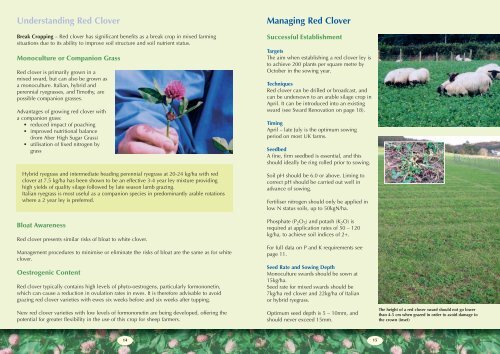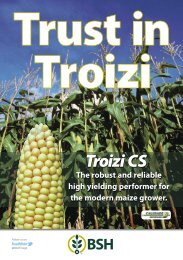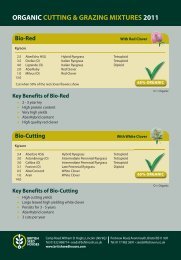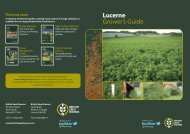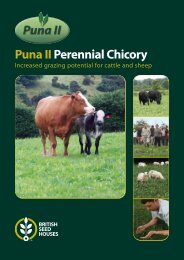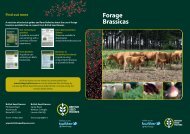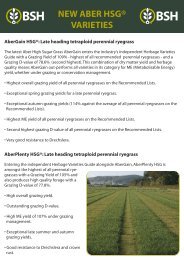You also want an ePaper? Increase the reach of your titles
YUMPU automatically turns print PDFs into web optimized ePapers that Google loves.
Understanding Red <strong>Clover</strong><br />
Break Cropping – Red clover has significant benefits as a break crop in mixed farming<br />
situations due to its ability to improve soil structure and soil nutrient status.<br />
Monoculture or Companion Grass<br />
Red clover is primarily grown in a<br />
mixed sward, but can also be grown as<br />
a monoculture. Italian, hybrid and<br />
perennial ryegrasses, and Timothy, are<br />
possible companion grasses.<br />
Advantages of growing red clover with<br />
a companion grass:<br />
• reduced impact of poaching<br />
• improved nutritional balance<br />
(from <strong>Aber</strong> High Sugar Grass)<br />
• utilisation of fixed nitrogen by<br />
grass<br />
Hybrid ryegrass and intermediate heading perennial ryegrass at 20-24 kg/ha with red<br />
clover at 7.5 kg/ha has been shown to be an effective 3-4 year ley mixture providing<br />
high yields of quality silage followed by late season lamb grazing.<br />
Italian ryegrass is most useful as a companion species in predominantly arable rotations<br />
where a 2 year ley is preferred.<br />
Bloat Awareness<br />
Red clover presents similar risks of bloat to white clover.<br />
Management procedures to minimise or eliminate the risks of bloat are the same as for white<br />
clover.<br />
Oestrogenic Content<br />
Red clover typically contains high levels of phyto-oestrogens, particularly formononetin,<br />
which can cause a reduction in ovulation rates in ewes. It is therefore advisable to avoid<br />
grazing red clover varieties with ewes six weeks before and six weeks after tupping.<br />
New red clover varieties with low levels of formononetin are being developed, offering the<br />
potential for greater flexibility in the use of this crop for sheep farmers.<br />
Managing Red <strong>Clover</strong><br />
Successful Establishment<br />
Targets<br />
The aim when establishing a red clover ley is<br />
to achieve 200 plants per square metre by<br />
October in the sowing year.<br />
Techniques<br />
Red clover can be drilled or broadcast, and<br />
can be undersown to an arable silage crop in<br />
April. It can be introduced into an existing<br />
sward (see Sward Renovation on page 18).<br />
Timing<br />
April – late July is the optimum sowing<br />
period on most UK farms.<br />
Seedbed<br />
A fine, firm seedbed is essential, and this<br />
should ideally be ring rolled prior to sowing.<br />
Soil pH should be 6.0 or above. Liming to<br />
correct pH should be carried out well in<br />
advance of sowing.<br />
Fertiliser nitrogen should only be applied in<br />
low N status soils, up to 50kgN/ha.<br />
Phosphate (P 2 O 5 ) and potash (K 2 O) is<br />
required at application rates of 50 – 120<br />
kg/ha, to achieve soil indices of 2+.<br />
For full data on P and K requirements see<br />
page 11.<br />
Seed Rate and Sowing Depth<br />
Monoculture swards should be sown at<br />
15kg/ha.<br />
Seed rate for mixed swards should be<br />
7kg/ha red clover and 22kg/ha of Italian<br />
or hybrid ryegrass.<br />
Optimum seed depth is 5 – 10mm, and<br />
should never exceed 15mm.<br />
The height of a red clover sward should not go lower<br />
than 4-5 cm when grazed in order to avoid damage to<br />
the crown (inset)<br />
14 15


